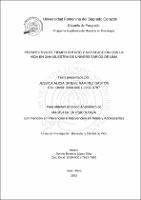Perspectiva de tiempo futuro y satisfacción con la vida en una muestra de universitarios de Lima
Abstract
La presente investigación de tipo cuantitativo, descriptivo y con un diseño transversal correlacional, tuvo como finalidad identificar la relación entre Perspectiva de tiempo futuro (PTF) y Satisfacción con la vida en un grupo de estudiantes universitarios en Lima. Participaron 133 estudiantes de pregrado que cursen los primeros ciclos de una carrera profesional de una universidad privada, de 18 y 19 años. El muestreo fue no probabilístico, dado que la población fue seleccionada considerando las características del estudio. La prueba de Perspectiva de tiempo futuro (R) desarrollada por Herrera, Martínez y Lens en el año 2010 y la Escala de Satisfacción con la Vida (SWLS) desarrollada por Diener, Emmons, Larson y Griffin en 1985, fueron empleadas para medir las variables. Los resultados dan a conocer que no todas las dimensiones y categorías (PTF) se vinculan con la satisfacción con la vida. Es entre el dominio De vida (PTF) y la Satisfacción con la vida donde se encontró una asociación directa y estadísticamente significativa (rs =.19, p < .05); en este espacio personal las metas comprenden aspectos concernientes a la educación, trabajo y familia. La categoría familia (PTF) es la que se relaciona de forma estadísticamente significativa con la Satisfacción con la vida (rs =.25, p < .01). Lo cual reafirma que a mayor presencia de metas relacionadas a la familia la satisfacción con la vida en estudiantes universitarios es mayor. Se concluye la importancia de la PTF en los jóvenes, por lo que se recomienda implementar acciones de orientación a los estudiantes y replicar la investigación con muestras más grandes. The present study of a quantitative, descriptive type and with a correlational cross-sectional design, aimed to identify the relationship between Future Time Perspective (TFP) and Satisfaction with life in a group of university students in Lima. 133 undergraduate students taking the first cycles of a professional career from a private university participated, aged 18 and 19. The sampling was non-probabilistic, since the population was selected considering the characteristics of the study. The Future Time Perspective (R) test developed by Herrera, Martínez and Lens in 2010 and the Satisfaction with Life Scale (SWLS) developed by Diener, Emmons, Larson and Griffin in 1985, were used to measure the variables. The results reveal that not all dimensions and categories (TFP) are linked to satisfaction with life. It is between the domain of Life (TFP) and Satisfaction with life where a direct and statistically significant association was found (rs = .19, p <.05); In this personal space the goals include aspects concerning education, work and family. The family category (TFP) is the one that is statistically significantly related to Satisfaction with life (rs = .25, p <.01). Which reaffirms that the greater the presence of goals related to the family, the greater the satisfaction with life in university students. The importance of TFP in young people is concluded, so it is recommended to implement orientation actions for students and replicate the research with larger samples.
Description
Tesis Bienestar y Calidad de Vida


